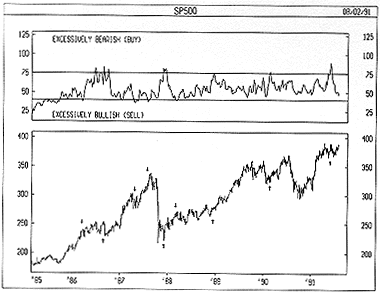|
PUTS/CALLS RATIO
Overview
Developed by Martin Zweig, the Puts/Calls Ratio ("P/C Ratio") is a market sentiment
indicator that shows the relationship between the number of Puts to Calls traded on the
Chicago Board Options Exchange (CBOE).
Traditionally, options are traded by unsophisticated, impatient investors who are lured
by the potential for huge profits with a small capital outlay. Interestingly, the actions
of these investors provide excellent signals for market tops and bottoms.
Interpretation
A Call gives an investor the right to purchase 100 shares of stock at a pre-determined
price. Investors who purchase Calls expect stock prices to rise in the coming months.
Conversely, a Put gives an investor the right to sell 100 shares of stock at a pre-set
price. Investors purchasing Puts expect stock prices to decline. (An exception to these
general rules is that Puts and Calls can also be purchased to hedge other investments, even
other options.)
Because investors who purchase Calls expect the market to rise and investors who
purchase Puts expect the market to decline, the relationship between the number of Puts to
Calls illustrates the bullish/bearish expectations of these traditionally ineffective
investors.
The higher the level of the P/C Ratio, the more bearish these investors are on the
market. Conversely, lower readings indicate high Call volume and thus bullish
expectations.
The P/C Ratio is a contrarian indicator. When it reaches "excessive" levels, the market
usually corrects by moving the opposite direction. The following table, general guidelines
for interpreting the P/C Ratio. However, the market does not have to
correct itself just because investors are excessive in their bullish/bearish beliefs! As
with all technical analysis tools, you should use the P/C Ratio in conjunction with other
market indicators.
|
Table 12 |
|
P/C Ratio 10-day Moving Average |
P/C Ratio 4-week Moving Average |
| Excessively Bearish (buy) |
greater than 80 |
greater than 70 |
| Excessively Bullish (sell) |
less than 45 |
less than 40 |
Example
The following chart shows the S&P 500 and a
4-week moving average of the Puts/Calls Ratio.
 I drew "buy" arrows when investors were
excessively pessimistic (greater than 70) and "sell" arrows when they were excessively
optimistic (less than 40). The arrows certainly show that investors are buying Puts when
they should be buying Calls, and vice versa.
I drew "buy" arrows when investors were
excessively pessimistic (greater than 70) and "sell" arrows when they were excessively
optimistic (less than 40). The arrows certainly show that investors are buying Puts when
they should be buying Calls, and vice versa.
Calculation
The Puts/Calls Ratio is calculated by dividing the volume of Puts by the volume of
Calls.

|

